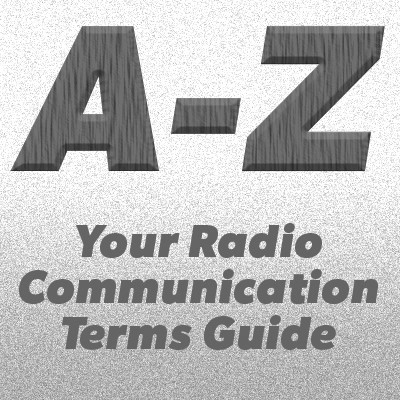An A-Z of radio communication terms

AM - Amplitude Modulation (receiver mode)
ANL - Auto Noise Limiter (helps reduce impulse noise interference).
AFC - Automatic Frequency Control (keeps the receiver tuned to the centre frequency of the station).
Audio Peak Filter - Reduces interference from nearby signals.
AGC - Automatic Gain Control. This matches the sensitivity of the receiver to the strength of the incoming signal.
Bandscope - Function that makes it easy to find busy frequencies and to observe receiver frequency band conditions.
Banks - Amalgamated group of channels.
CI-V system - A computer interface. Allows control of the radio from a PC (this does not include software)
Channel Spacing - The distance between the centre frequency of signals on channelled systems.
CTCSS - Continuous Tone Coded Squelch System. This filters out other signals whilst you are listening. It is principally used on commercial VHF & UHF radio systems but it is increasingly being introduced to radio amateur repeaters.
CW - Carrier Wave, also used to designate as Morse code signals.
Db - Decibel (measurement of sound)
DCS - Digital coded squelch
DDS - Direct Digital Synthesis. Icom's original system provides super fine tuning resolution to 1Hz.
EEPROM - Electronically Erasable Programmable Read Only Memory.
Filter - Components used to refine radio signals.
FM - Frequency Modulation (receiver mode)
GHz - Giga Hertz (1,000 MHz)
HF - High Frequency (3 MHz - 30 MHz)
Hz - Hertz (unit of frequency measurement)
IF shift - IF shift is used to reduce interference from nearby signals. It does so by adjusting the centre frequency of the IF filter.
kHz - Kilo Hertz (1000Hz)
LCD - Liquid Crystal Display
LF - Low Frequency (0 kHz - 300 kHz)
MF- Medium Frequency (300 kHz - 3 MHz)
MHz - Mega Hertz (1000 kHz)
Noise Blanker Circuit - Suppresses pulse type noises such as that caused by vehicle ignition systems.
PBT - Pass Band Tuning (Allows the centre frequency of the receiver IF filter to be moved relative to another similar filter. This reduces bandwidth and helps reduce interference from signals on adjacent frequencies).
RF Attenuator - Reduces the input signal to prevent overload of the radio.
RTTY - Radio Type Telegraphy
SDR - Software Defined Radio
SIGNAVI - Sub-receiver that moves across bands whilst you are listening therefore reducing the time of the scan.
Single Side Band - A method used to reduce the amount of bandwidth a signal occupies.
S-meter squelch - A pre-set threshold that tells you how strong the message is. When receiving levels stronger than the pre-set level a mute function kicks in and blocks annoying signals.
Squelch- Circuitry to suppress receiver noise in the absence of signals.
SHF - Super High Frequency (1300 MHz - 2000 MHz)
TS - Tuning Steps (The frequency stop used when moving up or down channels).
VSC - Voice Scanning Control (stops when a fully modulated signal is detected)
UHF - Ultra High Frequency (300 MHz - 1300 MHz)
V - Volt (measurement of Voltage)
VHF - Very High Frequency (30 MHz - 300 MHz)
WFM - Wide FM (receiver mode)

